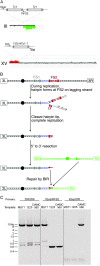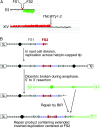Chromosome aberrations resulting from double-strand DNA breaks at a naturally occurring yeast fragile site composed of inverted ty elements are independent of Mre11p and Sae2p
- PMID: 19635935
- PMCID: PMC2766307
- DOI: 10.1534/genetics.109.106385
Chromosome aberrations resulting from double-strand DNA breaks at a naturally occurring yeast fragile site composed of inverted ty elements are independent of Mre11p and Sae2p
Abstract
Genetic instability at palindromes and spaced inverted repeats (IRs) leads to chromosome rearrangements. Perfect palindromes and IRs with short spacers can extrude as cruciforms or fold into hairpins on the lagging strand during replication. Cruciform resolution produces double-strand breaks (DSBs) with hairpin-capped ends, and Mre11p and Sae2p are required to cleave the hairpin tips to facilitate homologous recombination. Fragile site 2 (FS2) is a naturally occurring IR in Saccharomyces cerevisiae composed of a pair of Ty1 elements separated by approximately 280 bp. Our results suggest that FS2 forms a hairpin, rather than a cruciform, during replication in cells with low levels of DNA polymerase. Cleavage of this hairpin results in a recombinogenic DSB. We show that DSB formation at FS2 does not require Mre11p, Sae2p, Rad1p, Slx4p, Pso2p, Exo1p, Mus81p, Yen1p, or Rad27p. Also, repair of DSBs by homologous recombination is efficient in mre11 and sae2 mutants. Homologous recombination is impaired at FS2 in rad52 mutants and most aberrations reflect either joining of two broken chromosomes in a "half crossover" or telomere capping of the break. In support of hairpin formation precipitating DSBs at FS2, two telomere-capped deletions had a breakpoint near the center of the IR. In summary, Mre11p and Sae2p are not required for DSB formation at FS2 or the subsequent repair of these DSBs.
Figures






Similar articles
-
Sae2p phosphorylation is crucial for cooperation with Mre11p for resection of DNA double-strand break ends during meiotic recombination in Saccharomyces cerevisiae.Genes Genet Syst. 2008 Jun;83(3):209-17. doi: 10.1266/ggs.83.209. Genes Genet Syst. 2008. PMID: 18670132
-
Mre11-Sae2 and RPA Collaborate to Prevent Palindromic Gene Amplification.Mol Cell. 2015 Nov 5;60(3):500-8. doi: 10.1016/j.molcel.2015.09.027. Mol Cell. 2015. PMID: 26545079 Free PMC article.
-
The Mre11 complex is required for repair of hairpin-capped double-strand breaks and prevention of chromosome rearrangements.Cell. 2002 Jan 25;108(2):183-93. doi: 10.1016/s0092-8674(02)00614-1. Cell. 2002. PMID: 11832209
-
Emerging non-canonical roles for the Rad51-Rad52 interaction in response to double-strand breaks in yeast.Curr Genet. 2020 Oct;66(5):917-926. doi: 10.1007/s00294-020-01081-z. Epub 2020 May 12. Curr Genet. 2020. PMID: 32399607 Free PMC article. Review.
-
Structure-function relationships of the Mre11 protein in the control of DNA end bridging and processing.Curr Genet. 2019 Feb;65(1):11-16. doi: 10.1007/s00294-018-0861-5. Epub 2018 Jun 19. Curr Genet. 2019. PMID: 29922906 Review.
Cited by
-
Noncanonical outcomes of break-induced replication produce complex, extremely long-tract gene conversion events in yeast.G3 (Bethesda). 2021 Sep 27;11(10):jkab245. doi: 10.1093/g3journal/jkab245. G3 (Bethesda). 2021. PMID: 34568913 Free PMC article.
-
A genetic and structural study of genome rearrangements mediated by high copy repeat Ty1 elements.PLoS Genet. 2011 May;7(5):e1002089. doi: 10.1371/journal.pgen.1002089. Epub 2011 May 26. PLoS Genet. 2011. PMID: 21637792 Free PMC article.
-
Meiotic recombination initiation in and around retrotransposable elements in Saccharomyces cerevisiae.PLoS Genet. 2013 Aug;9(8):e1003732. doi: 10.1371/journal.pgen.1003732. Epub 2013 Aug 29. PLoS Genet. 2013. PMID: 24009525 Free PMC article.
-
The Ty1 LTR-retrotransposon of budding yeast, Saccharomyces cerevisiae.Microbiol Spectr. 2015 Apr 1;3(2):1-35. doi: 10.1128/microbiolspec.MDNA3-0053-2014. Microbiol Spectr. 2015. PMID: 25893143 Free PMC article.
-
Mechanisms and regulation of mitotic recombination in Saccharomyces cerevisiae.Genetics. 2014 Nov;198(3):795-835. doi: 10.1534/genetics.114.166140. Genetics. 2014. PMID: 25381364 Free PMC article. Review.
References
-
- Allers, T., and D. R. Leach, 1995. DNA palindromes adopt a methylation-resistant conformation that is consistent with DNA cruciform or hairpin formation in vivo. J. Mol. Biol. 252: 70–85. - PubMed
Publication types
MeSH terms
Substances
Associated data
- Actions
Grants and funding
LinkOut - more resources
Full Text Sources
Molecular Biology Databases
Research Materials

